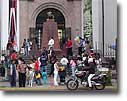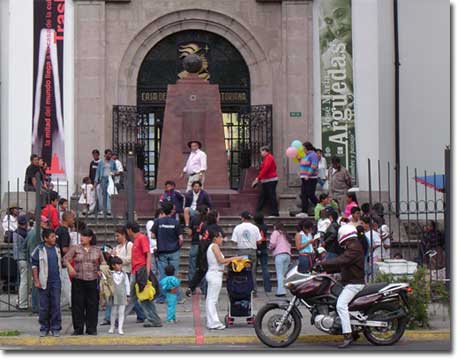Casa de la Cultura Ecuatoriana,
Apr 16, 2005 - May 10, 2005
Quito, Ecuador
La Mitad del Mundo...
by Bill Kelley Jr.
On arriving in Quito on April 12th one could sense tensions building as news reports of growing discontent were manifesting themselves into increasingly angry street demonstrations. President Lucio Gutierrez was to lose his job and almost his hide in the coming days as his unconstitutional projects, bordering on the dictatorial, caught up with him. Scores of Quiteños took to the streets, "caseroleros" up all night banging pots and pans in a semiotically charged spectacle - and loud as hell, echoing within the narrow colonial streets and among the 17th century churches of the historic and administrative center. Within days, Gutierrez was being held under diplomatic protection in the Brazilian Embassy in Quito. The crowds and noise grew, eventually being dispersed with teargas before several hundreds spilled onto the airport runway blocking all traffic and stopping any possible escape to Brazil for the recently deposed president. Disguised as routine traffic police, he and his family managed to avoid the mob waiting outside the embassy and fled the country in the middle of the night. On Saturday morning, the 16th, there was an opening in the northern end of the city. The Casa de la Cultura’s (CCE) museum director Maria Fernanda Cartagena organized a two part event featuring the work of two London/Quito based artists, Manuela Ribadeneira and Nelson García, known as Artes No Decorativas S.A.. The first part of the exhibition consisted of an outdoor installation and photography session, lasting only that weekend, the second entailing a commemorative plaque to be publicly presented and mounted a few weeks later in the interior grand entrance of the historic building. Within such a charged political environment, with so much at stake, can a work of art take us to a place of critical engagement? That's a tough question to ask of any work of art, but it's a fair one. Despite assurances that the artists were not making "political" art, I believe this unassuming institutional intervention had more than a few provocative issues to raise. What were they and what were the strategies of engagement? Consideration #1: My walk to the exhibition found me facing a miniaturized painted foam replica of the "Center of the World" monument on the steps leading to the entrance of the museum. "La Mitad del Mundo" is one of the most popular attractions in Ecuador, a hugely monumental tourist trap, if you will, quietly located an hour away in the countryside. It’s one of those in-between places that is neither internationally famous nor recognized yet its presence is ubiquitous at home (The country is called Ecuador after all). Visitors to the installation were invited to sit on the front steps with the monument as a backdrop. Outfitted in official event gear sponsored by Polaroid, the artists would take your Polaroid and place it in a colorful folding picture holder as your parting souvenir. The picture holder visitors were given is replete with familiar images: an Otavaleña with child, El Chimborazo, turtles from Galapagos, and of course, the duplicated national monument. The mirroring of "La Mitad del Mundo" in the city, as well as its inclusion within this montage is a not-so disguised glance to the nature of culture and its representation in contemporary Ecuador. With unprecedented amounts of money spent in recent years on urban renewal projects, including a new and massive 60,000 sq ft. museum of modern and contemporary art [Museo Antropológico y de Arte Contemporáneo (MAAC)] in the heart of the newly remodeled Melecón in Guayaquil, visitors may now find themselves at the CCE, literally watching cultural tourism unfold in a country whose cultural marketing and revenue generating potential are being debated front and center. This crisis of globalized finances and touristic identity is by no means an isolated or regional development.
|













